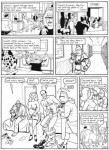Brad Rader, whose sketchbook collections I reviewed a couple of years ago, is back with a very unusual graphic novel.
Harry and Dickless Tom1 is the story of two middle-aged truckers, comfortable in the self-assurance of their masculine straightness, who are very close to each other and don’t balk at having it off with a fag here and there–as long as they don’t get fucked, of course. One morning, after another homophobic episode, Tom finds his dick replaced with a cunt. Add to that his still-closeted gay son and the son’s violently homophobic coach, and you get a tale of redemption with a healthy view of sex—including some rather hot sequences.
In my opinion, Brad Rader has written and drawn a story that can be called “queer” in ever meaning of the word. It’s weird, non-straight and, more than that, questions a lot of assumptions often made about sexual identities and man/woman relationships. It’s also one of the more sex-positive graphic novels I’ve read.
Another aspect that sets it apart from most of the gay-themed works I review here is the fact that Brad Rader is a mainstream artist, having worked on DC’s Catwoman, when it was a caper book with feminist overtones written by Ed Brubaker (here’s the collection at Amazon), and on the Bruce Timm cartoons. He brings to this book a variety of aesthetics, mainly from American comics, but not only. Which means that each chapter is drawn in a different style: we get the naiveté of Hergé’s Tintin, Neal Adams’s acid-born dreams in the late 60′s, Jim Steranko’s energy in his superhero work, the stark black-and-white of strips by Milton Caniff and Alex Raymond, and finally, Bernie Krigstein’s extremely controlled storytelling. If you don’t know all those artists, that won’t prevent you from enjoying the book, but if you do, you’ll be dazzled by the way Rader has managed to integrate all those references in his own style. That, and he draws really hot hairy guys.
It’s no wonder Brad Rader couldn’t find a publisher for this book. It shatters a lot of barriers and tells a story that’s as modern in its themes as it is classically drawn.
Notes:



 Bluesky feed
Bluesky feed